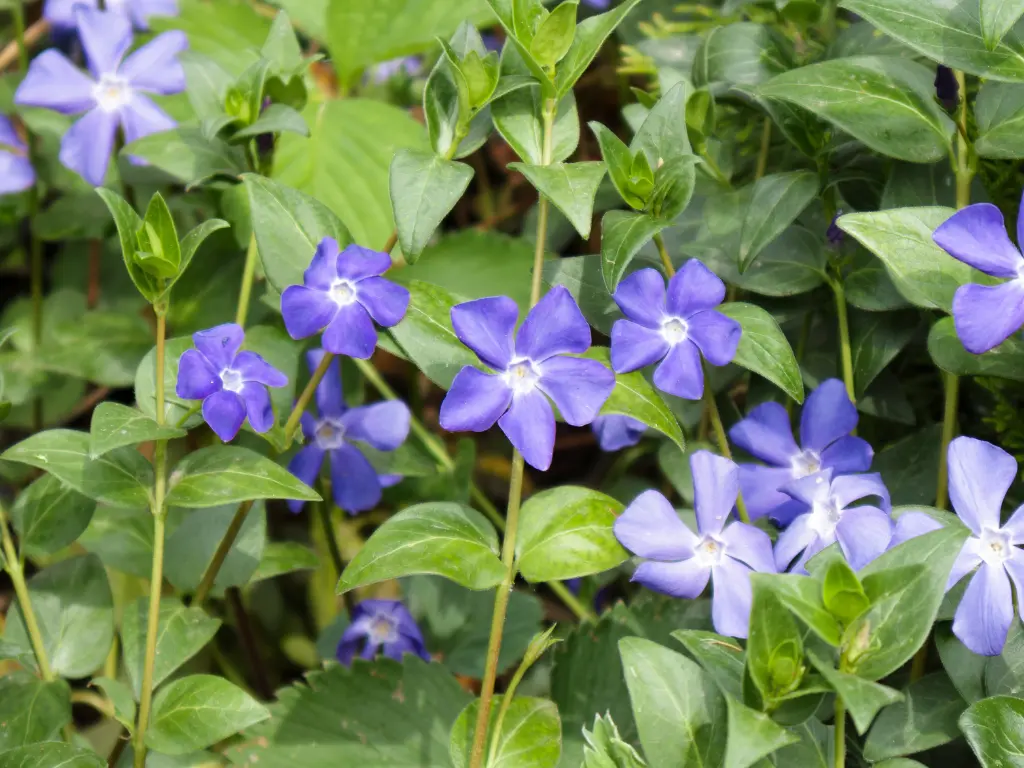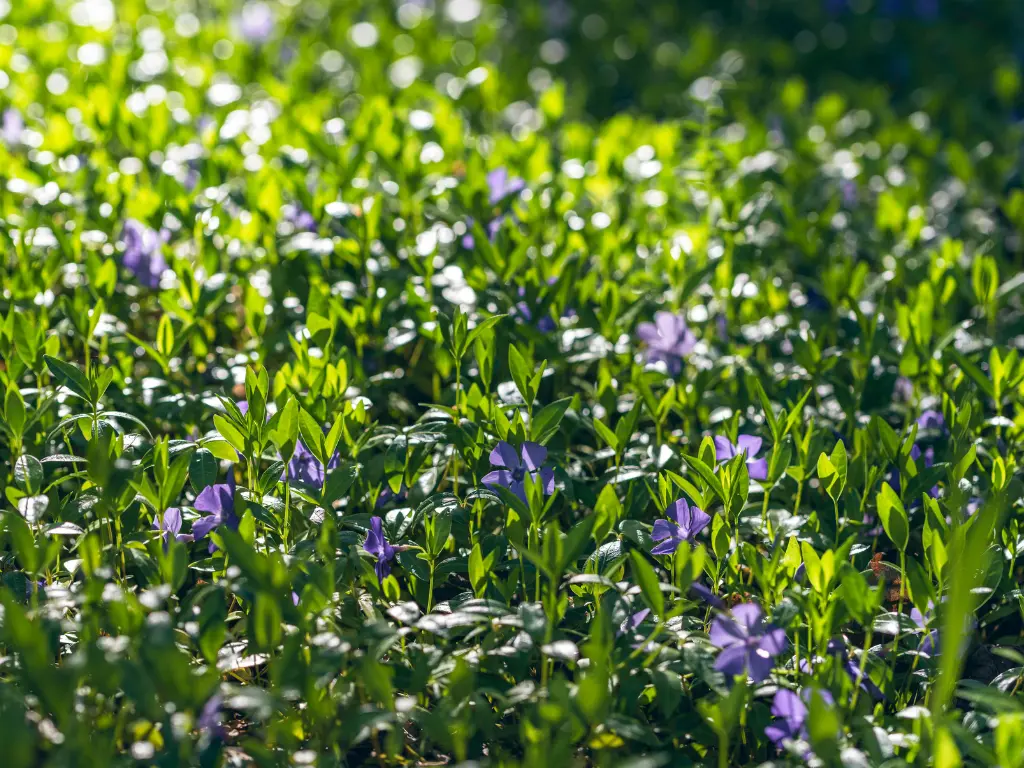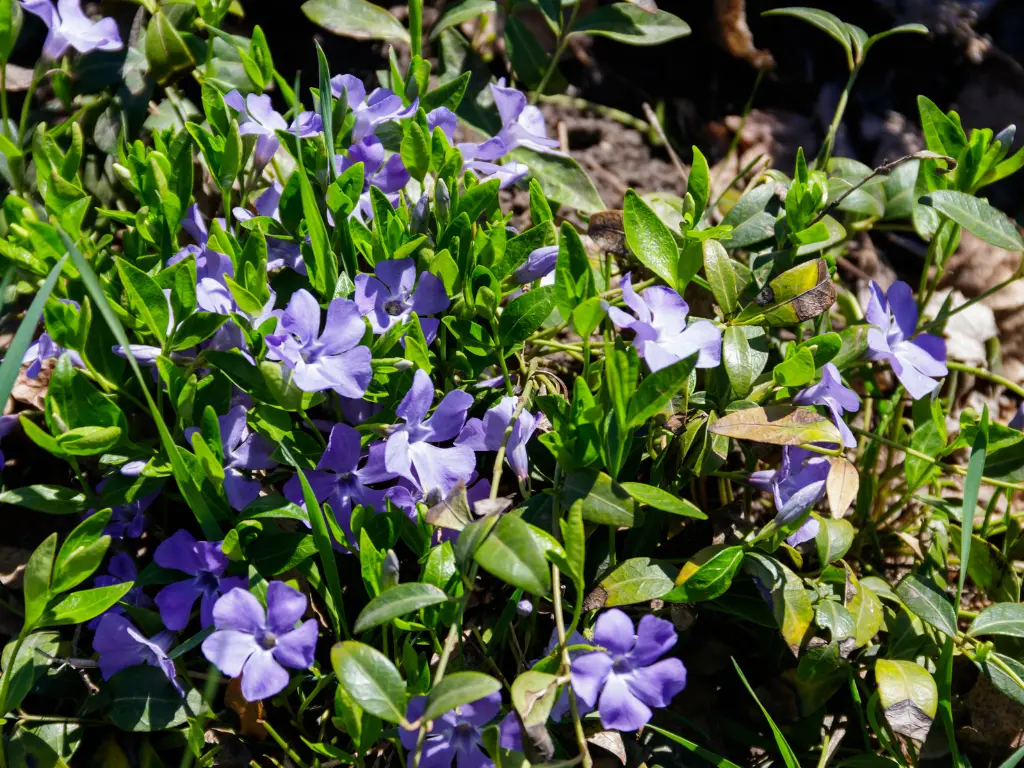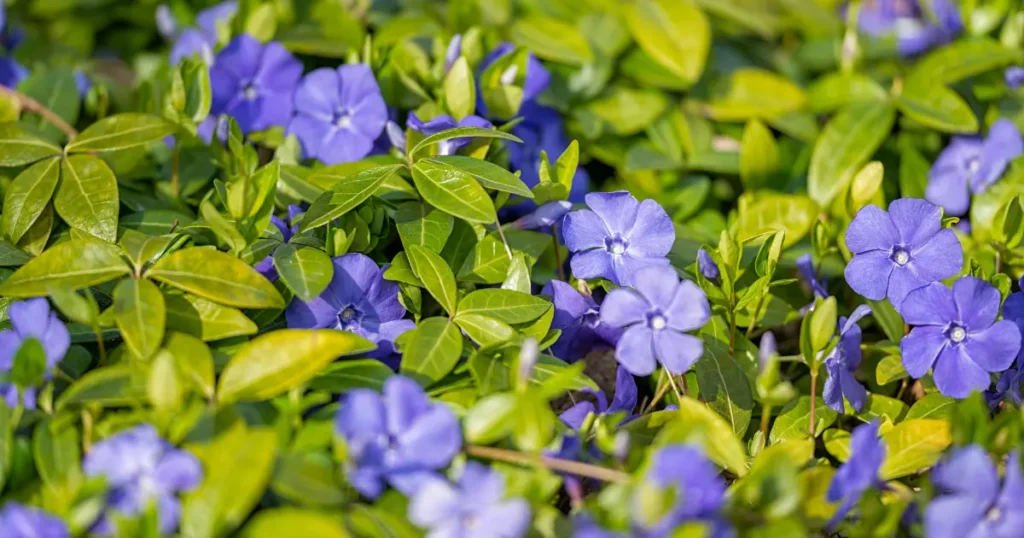Guides
How to Grow Vinca Periwinkle – Sprawling Ground Cover Plant for Your Garden
Vinca periwinkle, also known as Vinca minor, is a versatile, low-maintenance ground cover plant that can transform your garden. Whether you’re looking to cover a bare patch of soil or add a pop of color to your landscape, Vinca periwinkle offers a perfect solution.
But how do you grow this sprawling plant? What makes it so special? And how can you ensure it thrives year-round in your garden? Let’s dive in and explore everything you need to know about growing Vinca periwinkle.
In this guide, I’ll take you through the ins and outs of growing Vinca periwinkle, from planting tips to care instructions, all while focusing on how this sprawling plant can thrive in your garden.
What is Vinca Periwinkle?

Vinca periwinkle is an evergreen ground cover plant that’s a favorite among gardeners looking for something that’s both attractive and easy to maintain.
Its shiny, dark green leaves are paired with bright purple or blue flowers that bloom from spring to summer, giving your garden a lovely splash of color. This fast-growing plant spreads quickly, making it perfect for filling gaps in your garden, controlling soil erosion, and even beautifying dull, neglected areas.
Vinca periwinkle’s ability to thrive in shady areas is one of its standout features, which is why it’s often chosen for areas where other plants struggle to grow. Whether you have a shaded backyard or a dry, sunny garden, Vinca minor can be the perfect addition to your landscape.
You may like: How to Grow Yellow Trillium: The Ultimate Shade Garden Guide
Why Should You Grow Vinca Periwinkle?
If you’re wondering why Vinca periwinkle is so popular, here are a few reasons why it might be the perfect addition to your garden:
-
Low Maintenance: Vinca periwinkle requires very little attention once established. It thrives in a variety of soil types and doesn’t need frequent watering, making it perfect for busy gardeners.
-
Fast-Growing: If you want a ground cover that spreads quickly, Vinca minor won’t disappoint. This plant covers large areas in a short amount of time, providing you with an instant landscaping solution.
-
Aesthetic Appeal: With its glossy green leaves and vibrant flowers, Vinca periwinkle adds a burst of color to any garden. It blooms in the spring and can even continue blooming into the summer, ensuring your garden remains visually appealing throughout the growing season.
-
Invasive but Controllable: While it can spread rapidly, Vinca minor is relatively easy to manage and prune, ensuring that it doesn’t take over your garden.
How to Plant Vinca Periwinkle
Now that we’ve discussed why you should grow Vinca periwinkle, let’s dive into the step-by-step process of how to grow it successfully.
Best Time to Plant
The best time to plant Vinca periwinkle is during the spring or fall. These seasons offer the perfect weather conditions for the plant to establish its roots before the extreme temperatures of summer or winter kick in.
-
Spring Planting: Plant your Vinca periwinkle after the last frost has passed, and when the soil has started to warm up. Spring planting ensures the plant will have enough time to settle in and grow through the warmer months.
-
Fall Planting: If you prefer to plant in the fall, Vinca minor will still have enough time to establish itself before winter comes. It’s a great option for those who want to prep their garden for the following year.
Choosing the Right Location

One of the best features of Vinca periwinkle is its adaptability. This plant thrives in both full sun and partial shade, although it will bloom more profusely when it receives some sunlight. However, it can also thrive in areas with dappled shade or full shade, making it ideal for places where other plants struggle to grow.
When choosing a planting location, keep these tips in mind:
-
Avoid planting Vinca minor in areas where the soil is consistently waterlogged.
-
Vinca periwinkle grows best in well-drained soil, so choose a site with good drainage.
Preparing the Soil
Vinca minor is not particularly fussy about soil, but for optimal growth, ensure the soil is:
-
Loamy: Slightly acidic to neutral soil works best.
-
Well-drained: Ensure that excess water can drain away to prevent root rot.
-
Rich in organic matter: Improve the soil by adding compost or organic mulch to provide nutrients.
If your garden soil is heavy clay, consider improving its texture by adding compost or a soil amendment before planting.
Planting Vinca Periwinkle
Plant Vinca minor 2-3 inches apart to allow for ample spreading. This plant can quickly cover the ground and fill in bare patches when planted in clusters.
To plant:
-
Spacing: Space your Vinca periwinkle plants about 2-3 inches apart. This allows them to spread and fill in the ground quickly.
-
Digging: Dig a hole for each plant that’s about twice as wide as the root ball.
-
Planting: Place the plant in the hole and make sure the top of the root ball is level with the soil surface. Fill the hole with soil and press down gently.
-
Watering: Water the newly planted Vinca thoroughly. This helps settle the soil and ensures the roots have enough moisture to establish themselves.
Caring for Vinca Periwinkle Throughout the Seasons

Let’s look at how to care for your Vinca periwinkle in different seasons.
Spring and Summer Care
During the growing season, Vinca minor will require regular watering, especially if there’s a lack of rainfall. Aim to water deeply once a week during dry periods.
-
Watering: During the warmer months, make sure to water the plant deeply once a week if there’s no rainfall. The goal is to keep the soil slightly moist, but not soggy.
-
Pruning: To keep your Vinca periwinkle from becoming too invasive, prune it back in early spring before new growth begins. This will help maintain its shape and prevent it from spreading too much.
-
Mulching: Apply a layer of mulch around the base of the plant to conserve moisture and suppress weeds.
Fall and Winter Care
In fall and winter, Vinca minor doesn’t require much attention, but there are a few things you can do to ensure it survives the colder months:
-
Watering: Continue to water it occasionally if the weather is dry.
-
Winter Protection: While Vinca periwinkle is hardy, if you live in an area with extreme winter temperatures, you might want to cover it with a light layer of mulch for added protection.
Common Problems and Solutions
Vinca periwinkle is generally pest-resistant, but that doesn’t mean it’s entirely immune to issues. Here are a few common problems you may encounter, and how to fix them:
-
Root Rot: Caused by overly moist soil or poor drainage, root rot can be detrimental. Make sure your planting site has proper drainage.
-
Pests: Though rare, Vinca minor can sometimes attract aphids, slugs, or snails. Treat any infestations with organic insecticides or simply pick them off by hand.
How to Propagate Vinca Periwinkle
If you love Vinca minor and want to spread it throughout your garden, propagation is easy! There are two main methods to propagate Vinca minor:
Rhizome Division
-
In the spring or fall, dig up the roots of the plant.
-
Cut the rhizomes into sections, ensuring each section has a root attached.
-
Replant the sections in new locations, and they will begin to grow.
Growing from Seed
Vinca minor can also be propagated from seed, but this method takes more patience. Start seeds indoors and transplant the young plants outdoors once they’ve matured enough to handle the weather.
Final Thoughts
Vinca periwinkle is an excellent choice for gardeners looking for a low-maintenance, fast-growing ground cover plant. Whether you need to fill in bare spots or create a lush, evergreen landscape, Vinca minor is versatile and easy to care for. With the tips provided in this guide, you’ll be able to grow and maintain this beautiful plant with ease. Happy gardening!
Frequently Asked Questions (FAQs)
-
How long does it take for Vinca minor to spread?
Vinca minor is a fast-growing plant. Under ideal conditions, it can cover a large area in just one to two years. -
How fast does Vinca minor grow?
Vinca periwinkle is a fast-growing plant. It can spread up to 1 foot per year under optimal conditions. -
Can Vinca minor grow in full sun?
Yes, Vinca minor can grow in full sun, but it will bloom more profusely if it gets some partial shade. -
Will Vinca periwinkle take over my garden?
Vinca minor spreads quickly, but regular pruning and careful management will keep it under control. -
How do I maintain Vinca periwinkle over the winter?
You can add a light mulch layer around the plant to protect it from frost and continue watering sparingly if needed. -
Can Vinca periwinkle grow in the shade?
Yes! Vinca periwinkle thrives in partial to full shade, making it perfect for shaded areas of your garden. -
Is Vinca minor invasive?
While it can spread quickly, Vinca minor is generally easy to manage with regular pruning. We can prevent Vinca minor from becoming too invasive by pruning the plant regularly and keep it confined to areas where you want it to grow.


Swedish Ivy Care: How to Grow a Healthy, Thriving Plant
Have you ever looked at your Swedish Ivy and wondered why the leaves are turning [...]
Nov
Avoid These 10 Garlic Planting Mistakes for Bigger, Healthier Bulbs
Growing garlic at home is one of the most satisfying things a gardener can do [...]
Nov
How to Prevent Christmas Cactus Bud Drop: Tips for a Healthy Bloom
Have you ever noticed your beautiful Christmas cactus (Schlumbergera) starting to lose its buds just [...]
Nov
Discover 7 Stunning Types of Night-Blooming Cereus
Have you ever waited for a flower that only opens at night and then disappears [...]
Nov
How to Propagate Comfrey from Root Cuttings: Easy Guide for Beginners
If you’re looking to grow your own healthy comfrey plants without spending too much, propagating [...]
Nov
10 Best Christmas Plants to Gift This Holiday Season
The holiday season is finally upon us, and if you’re searching for the perfect gift [...]
Oct